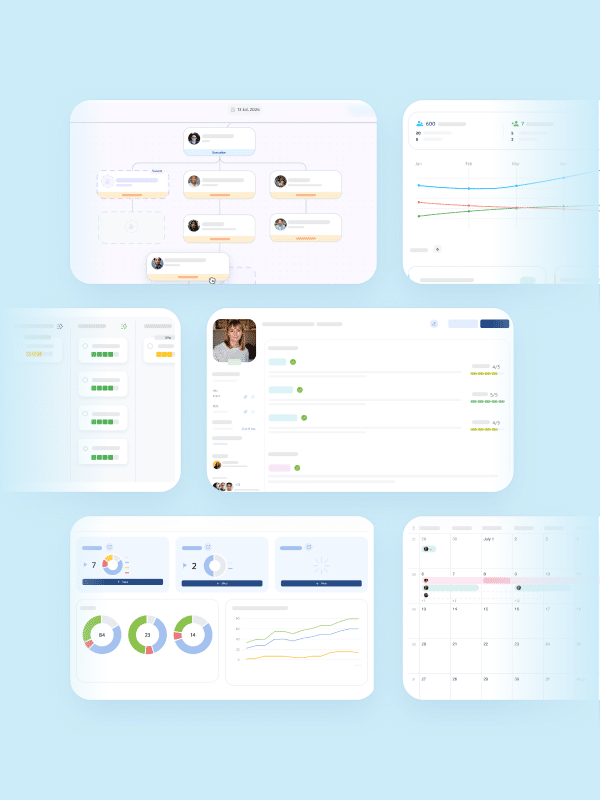Internal Benefits of an Inclusive and Automated Onboarding Process
9 Nov, 2023
9 min
Are you curious about the possibilities of an inclusive and automated onboarding process for your company? If you, like us, are interested in the topic, then you’ve come to the right place. In this article, we will explore automated onboarding, what it entails, how to implement it, and what the internal benefits are. Additionally, we will delve into how well-designed onboarding processes, which also involve colleagues of the newly hired, greatly contribute to internal community, engagement, and reinforce your employer brand.
What does an automated onboarding process entail?
An automated onboarding process is a systematic and technology-driven method of welcoming and integrating new employees into the organization. Instead of manual administration and the traditional use of paper forms, advanced HR software with a digital platform is used to make the entire onboarding experience smoother and more efficient. This includes managing various documentation in the onboarding process, various training initiatives, and an introduction to corporate culture and processes. A well-designed HR system plays a crucial role in this. But what are the internal benefits of an automated onboarding process?

Catrine Augustsson, HR Expert
“Automated onboarding isn’t just about efficiency; it’s the key to creating an inclusive workplace, fostering engagement, and building a strong employer brand.”
Benefits of an Automated Onboarding Process
When it comes to welcoming and introducing new employees to an organization, an automated onboarding process offers a range of significant advantages. This modern method not only improves efficiency but also has positive effects on costs, engagement, and consistency. Let’s explore the key advantages of using automation in the onboarding process.
- Time-saving: With automated onboarding, the time spent on managing various administrative tasks in the onboarding process is reduced. Employees can quickly fill out and submit necessary documents online, reducing paperwork and saving time for both HR and managers.
- Consistent introduction: When an automated process is used, it ensures that all new employees receive the same introduction, information, and undergo the same processes. This creates a uniform onboarding experience and reduces the risk of omitted steps or overlooking critical information.
- Cost-saving: Reduced paper usage and faster processes lead to cost savings. Moreover, it also helps reduce the risk of mistakes that can be time- and cost-intensive to rectify.
- Increased engagement: An efficient onboarding process provides new employees with what they need to quickly feel like part of the team. This often leads to increased engagement, satisfaction, and effectiveness.
- Clear communication: Automated onboarding makes it easier to communicate essential information to new employees, such as company policies, goals, and expectations.
- Consistency: With automated onboarding, it’s easier to ensure that new employees can follow the company’s rules and guidelines, reducing the risk of deviations or legal issues.
- Improved data management: All information collected during the onboarding process can be easily stored and managed electronically, facilitating reporting and tracking of employees’ needs, performance, and development.
As you can see, an automated onboarding process has many benefits for the business. It not only reduces administrative workload but also contributes to creating a more engaged and efficient workforce.
However, an automated onboarding process can be much more than just an efficient administrative and technical procedure. It can also be the key to creating an inclusive work environment, which, in turn, can positively impact your organization’s success and employer brand. Here are some additional valuable ways that an automated onboarding process can bring about:
Automated onboarding processes offer several advantages for the organization. First, it reduces the risk of unintentional bias in the selection and onboarding process by focusing on objective criteria and standardized procedures. This enables fair decision-making and also contributes to creating diversity in the workplace.
Furthermore, automated onboarding allows for customization to individual needs and interests. When the introduction is tailored to the individual needs and expectations of new employees, the organization can better meet their expectations and create the desirable feeling of being a significant part of the business.
Cultural awareness is another advantage, as automated processes can include insights into the company culture and the values adhered to in the organization. This makes it easier for new employees to understand and adapt to the organization’s unique culture, which, in turn, fosters a shared understanding of the corporate culture and promotes stronger internal cohesion.
Clear communication is another key factor. Automated processes ensure that vital information about company policies, goals, and expectations is communicated clearly. This approach signals transparency while reducing the risk of misunderstandings.
Another crucial aspect of the onboarding process is participation. Involving colleagues and team members in the onboarding process encourages interaction and social collaboration, helping new employees quickly feel like part of the team. Moreover, it facilitates building strong internal networks.
Let’s continue by taking a closer look at how colleagues’ participation in the onboarding process can strengthen internal community, increase engagement, and enhance employer branding.
How can colleagues’ participation in the onboarding process enhance internal community, boost engagement, and reinforce employer branding?
To understand how well-designed automated onboarding processes that involve colleagues can enrich the internal community, increase engagement, and reinforce the employer brand, it is important to highlight the dimensions on which this approach is based.
- Internal Community: When new employees are integrated with colleagues through automated onboarding, more than just an administrative process occurs. An experience is created where new team members quickly feel like part of the team. The inclusive dimension facilitates collaboration and social interaction, strengthening internal networks and creating a sense of community. With colleagues actively participating in the process, the introduction becomes more personal and meaningful, helping to open up collaboration and support mutual trust.
- Engagement: Automated onboarding processes that include colleagues create opportunities for increased participation and enhanced collaboration. This also benefits faster learning and adaptation to the workplace, which, in turn, increases engagement and efficiency. New employees feel more appreciated and valuable when they receive direct support and guidance from colleagues, creating a solid foundation for a positive work environment.
- Employer Branding: The inclusive dimension of automated onboarding strengthens employer branding in several ways. First, it clearly communicates the organization’s commitment to an inclusive work environment, attracting candidates who share these values. Second, it creates positive experiences for new employees, increasing their likelihood of becoming advocates for the company. These types of positive workplace stories naturally spread to potential new employees, strengthening the employer brand as both attractive and inclusive.
Automated onboarding processes that involve colleagues are more than just an administrative routine. They are a key component in creating a strong internal community, increasing engagement, and reinforcing the employer brand. By promoting interaction, participation, and an inclusive culture, organizations can build robust internal relationships that not only benefit employees but also influence how they are perceived externally. This two-way impact is a crucial factor for organizations’ success and growth in today’s competitive job market.

Browse our webinar library!
We have a number of webinars about different HR related topics available to watch whenever you want.
How do you implement automated onboarding in the organization?
Integrating automated onboarding into the organization is a significant step toward reaping its benefits. Here are some fundamental steps to help you get started:
-
- Identify the Needs: First and foremost, the organization’s specific needs must be identified. What documents and processes need to be automated? What type of HR software best fits your needs?
- Choose the Right HR System: It is crucial to select HR software that suits your needs. Ensure it has features to efficiently manage the onboarding process.
- Design the Onboarding Process: Create a structured onboarding process that includes all necessary information and training for new employees.
- Train the Staff: Ensure that staff, including HR and managers, are trained in using the new system.
- Testing and Adjustments: Before launching the system widely, test it with a few new employees and address any issues that arise.
- Communicate the Approach: Inform everyone in the organization about the new onboarding process and why it’s being implemented. Clear communication is key to success.
- Monitoring and Evaluation: Follow up and evaluate the results of automated onboarding continuously. Make any necessary adjustments as needed.
Last but not least, by carefully planning, selecting the right system, designing a structured process, training the staff, and continuously evaluating, you can make the most of automated onboarding.

Do you want to see more?
Book a demo here to see Heartpace HR system
Towards a Better Workplace
Automated onboarding is much more than just an administrative advantage. It is the key to an inclusive and well-functioning workplace. This automated method of welcoming and integrating new employees is not only efficient; it is a catalyst that strengthens the organization’s internal cohesion and employer brand.
The inclusive dimension in the onboarding process creates an environment where everyone feels welcome and valued. This means actively focusing on individual needs and interests while promoting a culture of openness and participation.
When colleagues and team members are involved in the onboarding process, opportunities for interaction and social collaboration are created, contributing to faster integration and stronger internal networks.
If you are looking for a solution that provides these opportunities and benefits, you are welcome to contact us to book a demo of the Heartpace HR System!
Welcome to the future of onboarding with us at Heartpace!
Explore more posts
Want to keep updated?
Subscribe to our blog posts, news and webinars here. We promise that we won’t overwhelm you with emails, nor will we never ever give your email address to anyone else!








